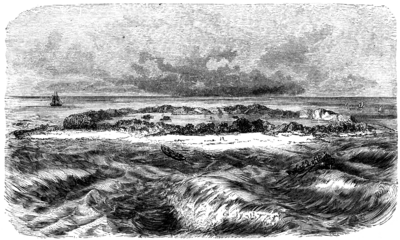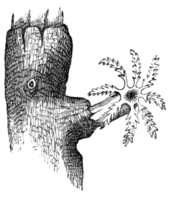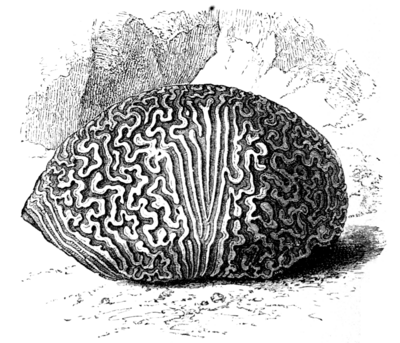The Ocean and Its Wonders/Chapter 15

 any of the large and beautiful islands that stud the Pacific Ocean, like emeralds in a field of blue, are artificial; that is to say, they were made by artists—they were actually built by artisans!
any of the large and beautiful islands that stud the Pacific Ocean, like emeralds in a field of blue, are artificial; that is to say, they were made by artists—they were actually built by artisans!
These artisans are the coral insects; and as they not only affect the face of the sea by raising large islands above it, but also, in consequence of their labours, assist in causing the circulation of the ocean, we think they are justly entitled to very special attention.
The great archipelago called Polynesia covers an area of the Pacific nearly 5000 miles in length, and not far short of 2000 in breadth. Some of the islands of this group are of volcanic origin, and some are crystal; but by far the greater number are of coral formation—the work of those curious little insects, which are so small that they inhabit a dwelling sometimes little larger than a pin-point. The manner in which these islands are made is, to some extent, a matter of uncertainty. The most generally received opinion is, that the insects fasten round the summit of a submarine mountain, and build upwards until they reach the surface of the sea, where they die, and their labours cease. As, however, the sea is sometimes unfathomable close to those islands, it has been supposed that the submarine islands on which the corallines began to build have gradually subsided, and that, as they did so, the insects always built a little more, so as to keep the top of their structures on a level with the sea. Above the sea they cannot build. To be washed by the waves is essential to their existence.
We do not think this a very satisfactory theory, because it supposes a prolonged subsiding of these islands, and then an unaccountably sudden stoppage. For although the corallines might continue to build during the whole time of subsidence, it were utterly impossible that the coral island, with its luxuriant herbage, could be formed until that subsidence should have ceased. The manner in which the islands are formed makes this obvious.
When the coral reef, as it is called, reaches the surface, it advances no further. Soon the action of the waves breaks off the branches of the upper portions of coral, which are tossed upon the reef, and pulverized into fine sand. This goes on increasing until the island rises a little above the waves. When this happens, birds alight there; sea-drift 
A CORAL ISLAND

CORAL INSECT.
But be that as it may, we have no difficulty in understanding the fact that the coral insect does build those islands. It possesses the power of secreting the lime held in solution by sea water, and depositing the same on the rocks below the waves. The coral rock is the edifice of the coralline. The insect itself is a soft and very minute worm, which, when washed by the waves, thrusts its head out of its tiny little door, and spreading I abroad its numerous feelers, so that it resembles a beautiful little star, moves these about as if enjoying itself—though, doubtless, it is actually engaged in the process of manufacturing its little atom of coral rock.
It is extremely interesting to think of the immense power of union thus exhibited. Singly, those little creatures could not produce a sufficient result to attract the attention of any creature save such as chanced to come in direct and close contact with its little cell. United, they have formed vast islands, which have become the abode of man, and which, in the aggregate, form no inconsiderable portion of the globe.
The consideration of this leads us to perceive that God has ordained that units cannot, separately, accomplish much; and that united effort, in order to be successful, requires the harmonious action of units. "A house divided against itself cannot stand." The innumerable and eminently beautiful isles of the Pacific had never stood where they now stand if the curious, and separately insignificant, little architects that reared them had not wrought unitedly upon a fixed and systematic plan—each insect working its utmost from the hour of its birth until that of its death.
There are various kinds of coral insects, which form varied species of coral rock. Some kinds of coral assume the form of rounded masses; some are like a branching shrub; others are in layers, or thin plates; and some are shaped like the human brain, from which they derive their name—brain-stones. These different kinds differ also in colour, and thus present a beautiful appearance when seen at the bottom of clear and shallow water.
In regard to the rate at which the corallines build their cells there is some diversity of opinion—some asserting that the process is imperceptible, while others state as positively that it is rapid. There 
BRANCHING CORAL.

BRAIN-STONE CORAL.
they were found to have risen nearly to the surface, and to have attached themselves to the solid rock.
There is also a case mentioned of a ship in the Persian Gulf which, in the course of twenty months, had her copper encased with living coral to the thickness of two feet.
On the other hand, it is asserted, and we doubt not with equal truth, that many reefs do not seem to increase in size in the course of many years.
When a coral reef has reached the surface, the formation of an island instantly begins; but it necessarily takes a long time ere this island becomes habitable by man. Among the first plants that raise their heads to the sea-breeze is the graceful cocoa-nut palm. This tree is exceedingly hardy, and is found growing on reefs which are so low that at a distance the trees seem to be standing on the surface of the water. Indeed many of them spring out of the pure white sand, and their roots are washed perpetually by the salt spray. Nevertheless, the fruit of such trees is sweet and good.
Coral islands of the kind we have just described seldom rise more than a few feet above the level of the sea; but most of them are clothed with luxuriant vegetation.
We might easily fill a volume on the subject of the ocean's inhabitants, small and great; but we think the few to which we have made reference is sufficient for the purpose of showing that one set of creatures accounts for that strange luminosity of the ocean which is seen at times in all marine parts of the globe, while another set accounts not only for the sudden appearance of coral islands in the sea where no such islands existed in days of old, but also, partly, for that circulation of the waters of the ocean which is absolutely necessary to the wellbeing of all the creatures on this earth.
There are other animals in the sea, besides medusæ, which assist in giving luminosity to its waters; and there are other insects, besides corallines, which extract its lime, destroy its equilibrium, and assist in causing its perpetual motion; but the two species which we have described are the best types of the respective classes to which they belong.
![]()
This work was published before January 1, 1929, and is in the public domain worldwide because the author died at least 100 years ago.
Public domainPublic domainfalsefalse